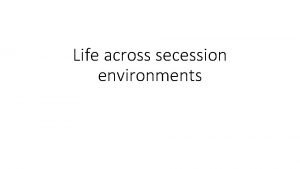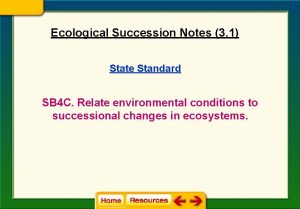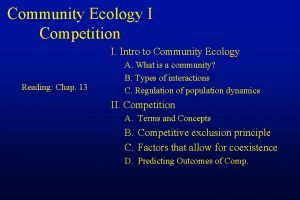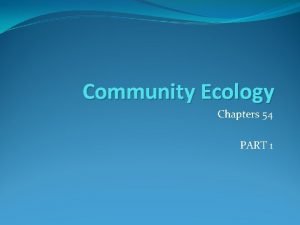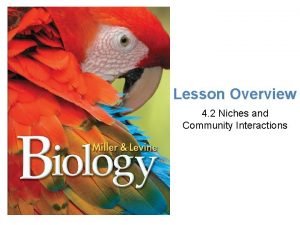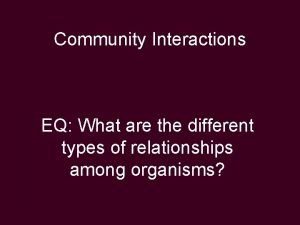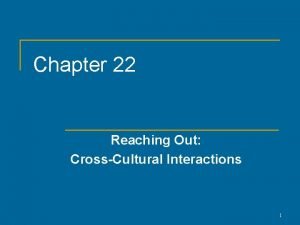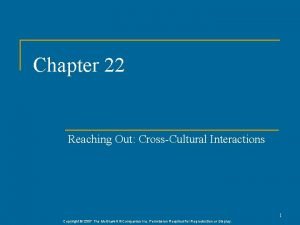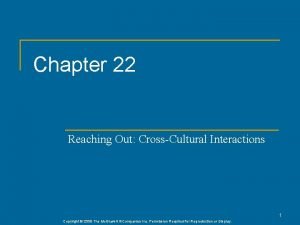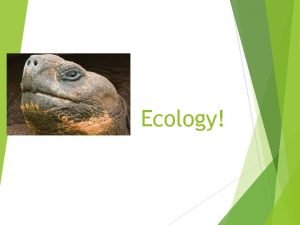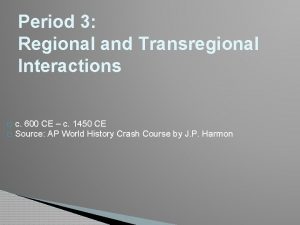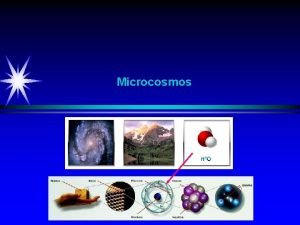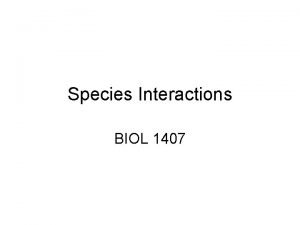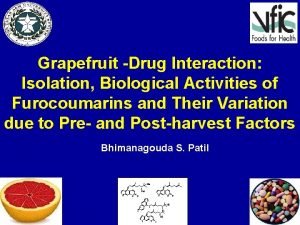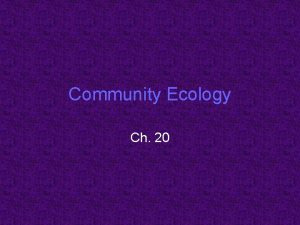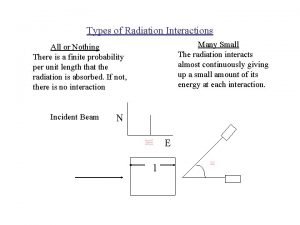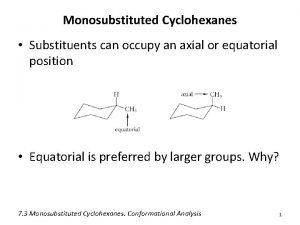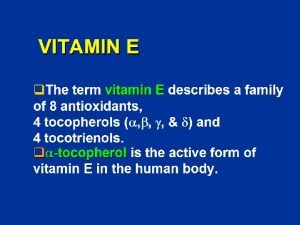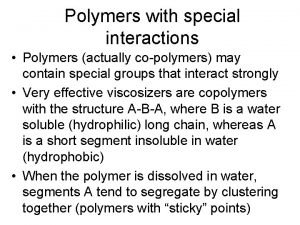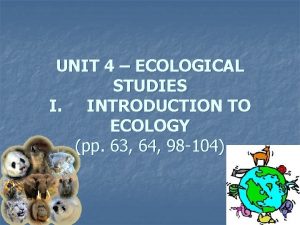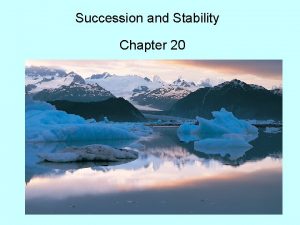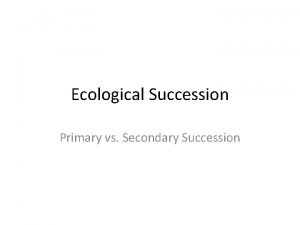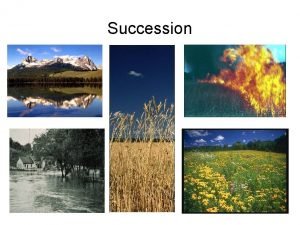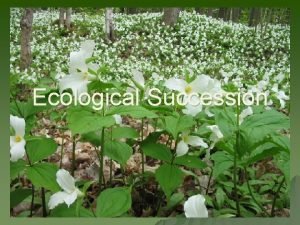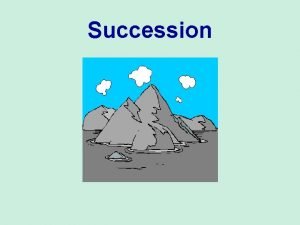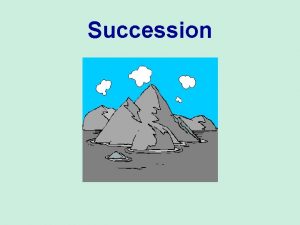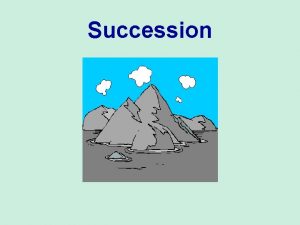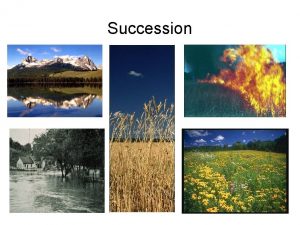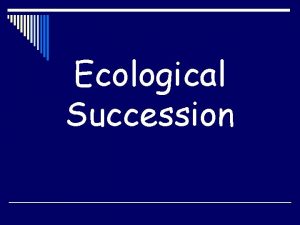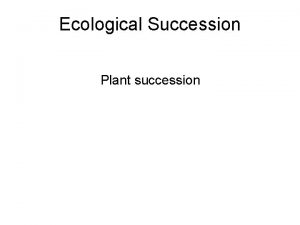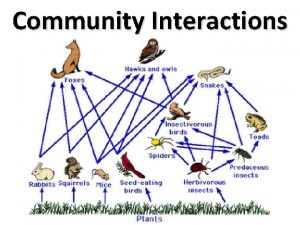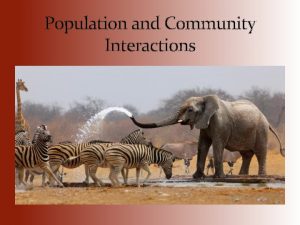Niche Community Interactions and Succession Chapter 19 Niche












































- Slides: 44

Niche, Community Interactions and Succession Chapter 19

Niche A niche is the range of physical and biological conditions in which a species lives and the way the species obtains what it needs to survive and reproduce.

Tolerance Every species has its own range of tolerance, the ability to survive and reproduce under a range of environmental circumstances.

Tolerance Organisms have an upper and lower limit of tolerance for every environmental factor. Beyond those limits, the organism cannot survive.

Tolerance When an environmental condition, such as temperature, extends in either direction beyond an organism’s optimum range, the organism experiences stress. The organism must expend more energy to maintain homeostasis, and so has less energy left for growth and reproduction.

Habitat A species’ tolerance for environmental conditions, then, helps determine its habitat—the general place where an organism lives.

Niche and Resources The term resource can refer to any necessity of life, such as water, nutrients, light, food, or space. For plants, resources can include sunlight, water, and soil nutrients. For animals, resources can include nesting space, shelter, types of food, and places to feed.

Physical Aspects and Niche Part of an organism’s niche involves the abiotic factors it requires for survival. Most amphibians, for example, lose and absorb water through their skin, so they must live in moist places.

Biological Factors and Niche Biological aspects of an organism’s niche involve the biotic factors it requires for survival. Birds on Christmas Island all live in the same habitat but they prey on fish of different sizes and feed in different places.

Polar bears live in the arctic. The arctic is their a. b. c. d. niche. habitat. tolerance. microclimate.

Which of the following is a biological aspect of an organism’s niche? a. the water in the area b. the way it gets food c. amount of sunlight d. composition of soil

Competition How one organism interacts with other organisms is an important part of defining its niche. Competition occurs when organisms attempt to use the same limited ecological resource in the same place at the same time.

Intraspecific Competition between members of the same species.

Interspecific Competition between members of different species.

Competitive Exclusion Principle Direct competition between different species almost always produces a winner and a loser—and the losing species dies out. Dotted line – grown separately Solid line – grown together

Competitive Exclusion Principle The competitive exclusion principle states that no two species can occupy exactly the same niche in exactly the same habitat at exactly the same time.

Dividing Resources Instead of competing for similar resources, species usually divide them.

Dividing Resources The resources utilized by these species are similar yet different. Therefore, each species has its own niche and competition is minimized.

No two species can occupy the same niche in the same habitat at the same time a. because of the interactions that shape the ecosystem. b. unless the species require different abiotic factors. c. because of the competitive exclusion principle. d. unless the species require different biotic factors.

Several species of warblers can live in the same spruce tree ONLY because they a. have different habitats within the tree. b. don’t eat food from the tree. c. occupy different niches within the tree. d. can find different temperatures within the tree.

Predator-Prey Relationships An interaction in which one animal (the predator) captures and feeds on another animal (the prey) is called predation.

Predator Prey Relationships Predators can affect the size of prey populations in a community and determine the places prey can live and feed. Idealized computer model

Herbivore Plant Relationship An interaction in which one animal (the herbivore) feeds on producers (such as plants) is called herbivory.

Herbivore Plant Relationship Herbivores, like a ring- tailed lemur, can affect both the size and distribution of plant populations in a community and determine the places that certain plants can survive and grow.

Keystone Species A keystone species is one whose impact on its community or ecosystem is disproportionately large relative to its abundance.

Keystone Species A species whose very presence contributes to the diversity of life and whose extinction would result in the extinction of species dependant on it.

Symbiosis The close and often long -term interactions between biological species. Mutualism Parasitism Commensalism

Mutualism Also known as cooperation. Both organisms gain a fitness benefit. Ex, clown fish and anemone

Parasitism Relationships in which one organism lives inside or on another organism and harms it. Generally, parasites weaken but do not kill their host, which is usually larger than the parasite.

Commensalism A relationship in which one organism benefits and the other is neither helped nor harmed. Ex, barnacles on whale

Succession Ecosystems change over time, especially after disturbances, as some species die out and new species move in. Ecological succession is a series of more-or-less predictable changes that occur in a community over time.

A symbiotic relationship in which both species benefit is a. commensalism. b. mutualism. c. predation. d. parasitism.

A symbiotic relationship in which one organism is harmed and the other benefits is a. mutualism. b. parasitism. c. commensalism. d. predation.

Primary Succession Volcanic explosions can create new land or sterilize existing areas. Retreating glaciers can have the same effect, leaving only exposed bare rock behind them.

Primary Succession that begins in an area with no remnants of an older community is called primary succession.

Primary Succession The first species to colonize barren areas are called pioneer species. One ecological pioneer that grows on bare rock is lichen —a mutualistic symbiosis between a fungus and an alga.

Secondary Succession Sometimes, existing communities are not completely destroyed by disturbances. In these situations, secondary succession occurs.

Secondary Succession Secondary succession proceeds faster than primary succession, in part because soil survives the disturbance. As a result, new and surviving vegetation can regrow rapidly.

Why Does Succession Occur? Every organism changes the environment it lives in. One model of succession suggests that as one species alters its environment, other species find it easier to compete for resources and survive.

Succession after Disturbance Healthy coral reefs and tropical rain forests often recover from storms, and healthy temperate forests and grasslands recover from wildfires.

Succession after Human-Disturbance Ecosystems may or may not recover from extensive humancaused disturbances. Clearing and farming of tropical rain forests, for example, can change the microclimate and soil enough to prevent regrowth of the original community.

Primary succession would most likely occur after a. b. c. d. a forest fire. a lava flow. farm land is abandoned. a severe storm.

An example of a human-caused disturbance is a. b. c. d. a hurricane. forest-clearing. wildfires. growing lichens.

What is one difference between primary and secondary succession? a. Primary succession is rapid and secondary succession is slow. b. Secondary succession begins on soil and primary succession begins on newly exposed surfaces. c. Primary succession modifies the environment and secondary succession does not. d. Secondary succession begins with lichens and primary succession begins with trees.
 Ecological succession succession of a pond
Ecological succession succession of a pond Ecological succession succession of a pond
Ecological succession succession of a pond Can a realized niche be larger than a fundamental niche
Can a realized niche be larger than a fundamental niche Resource partitioning example
Resource partitioning example 6.1 habitats niches and species interactions
6.1 habitats niches and species interactions Niches and community interactions
Niches and community interactions Parasitism
Parasitism Hydrarch type of succession does not start on
Hydrarch type of succession does not start on Chapter 22 reaching out cross-cultural interactions
Chapter 22 reaching out cross-cultural interactions Chapter 22 reaching out cross-cultural interactions
Chapter 22 reaching out cross-cultural interactions Chapter 22 reaching out cross-cultural interactions
Chapter 22 reaching out cross-cultural interactions Which of the following tells you population density
Which of the following tells you population density Interactions between ais and internal and external parties
Interactions between ais and internal and external parties Application forms qualitative or quantitative
Application forms qualitative or quantitative Expansionary fiscal policy graph
Expansionary fiscal policy graph The properties and interactions of magnets
The properties and interactions of magnets Sphere interactions examples
Sphere interactions examples Product architecture example
Product architecture example Factors influencing business communication
Factors influencing business communication Symbiosis and species interactions keystone webquest
Symbiosis and species interactions keystone webquest Naive bayes pays attention to complex interactions and
Naive bayes pays attention to complex interactions and Modular and integral architecture
Modular and integral architecture Regional and transregional interactions
Regional and transregional interactions Fundamental particles and interactions
Fundamental particles and interactions Regional and transregional interactions
Regional and transregional interactions Noncovalent interactions
Noncovalent interactions Congress formal and informal powers
Congress formal and informal powers Parasitism
Parasitism Example of commensalism
Example of commensalism Sertraline interactions
Sertraline interactions Felodapine
Felodapine Interactions within ecosystems grade 7
Interactions within ecosystems grade 7 Abiotic factor
Abiotic factor Section 20-1 review species interactions
Section 20-1 review species interactions Some students are instructed to put a celery stalk
Some students are instructed to put a celery stalk Moa of h2 antagonist
Moa of h2 antagonist Types of interactions
Types of interactions Circulatory system interactions with other systems
Circulatory system interactions with other systems Diaxial interactions
Diaxial interactions Ppi drug interactions
Ppi drug interactions Functions of the digestive system
Functions of the digestive system Cobalomin
Cobalomin Special interactions
Special interactions Glipizide interactions
Glipizide interactions Heterotrophs
Heterotrophs
